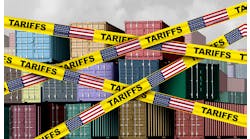Shippers and businesses worldwide—especially in Asia—appear to have shifted the way they move items and goods. Earlier this year FedEx reported its third straight year-over-year decline in quarterly net profit, and blamed much of the drop on a massive move away from the company's most premium, highest-speed services.
It's not that FedEx's aircraft are empty. It's just that, instead of paying to ship something overnight, companies are increasingly paying less to ship something more slowly. Delivery is still guaranteed, just not as fast—and importantly, not nearly as expensive.
UPS has been reporting the same trend. And both companies, as well as air cargo industry observers, believe the trend may be permanent. Shippers are doing a little more planning and spending money more wisely. FedEx and UPS are strong companies with diversified product offerings, so they can certainly adjust. (FedEx announced last March that it will cut capacity to/from Asia.) But both are likely doing some serious thinking about how they price and market their offerings.
Industry Numbers Aren't Pretty
The air carriers are hungry for any good news after five years of stagnation. The level of international airfreight traffic was essentially the same in 2012 as 2007.
"We've had 12 years [of data dating back to 2000], almost two-thirds of a 20-year forecast period, where air cargo has only averaged 3%" annual traffic growth, says Air Cargo Management Group (ACMG) managing director Robert Dahl. That's about half of the 6% annual growth rate experienced by the industry until the middle part of the last decade.
"It's reasonable to expect that 3% could be what the new normal will be," Dahl adds. After rebounding from back-to-back down years with a 20% uptick in 2010, global air cargo traffic fell 0.7% in 2011 and was down 1.9% through the first nine months of 2012, according to IATA.
United Parcel Service's 2012 third-quarter revenue was down 0.7% year-over-year to $13.07 billion as the delivery giant contended with what chairman and CEO Scott Davis characterizes as "an environment of slowing global trade." CFO Kurt Kuehn told analysts that UPS customers continue to "migrate to less premium products."
Similarly, FedEx chairman, president and CEO Fred Smith said in recent public comments that "some customers are trading off speed for cost savings," adding the trend "will continue for the foreseeable future, likely even when economic conditions improve."
IATA analysts, at the organization's outlook briefing in mid-December, confirmed a gloomy forecast for the cargo business, with asset utilization continuing to decline. But IATA chief economist Brian Pearce noted there were signs of U.S. consumers becoming more confident, which could "help put a floor under" goods migrating to surface transport.
Air cargo "yields are going down and capacity is ample … there's overcapacity," Accenture senior manager Marcus Fromm says. "There's very little appetite and courage in [the air cargo] industry to really do the next step of innovation. Little increases in fuel prices have a huge impact [on whether an air cargo route is profitable. Airfreight operators need to be] applying more intelligence on how you sell and what you sell. The industry needs to come off this kind of attitude about complaining about the volatility" and provide a higher value proposition to shippers.
Dahl adds, "One of the issues that operators of freighters face today is the high price of fuel. There's only one revenue stream—from the cargo you carry—and there's downward pressure on yields. The airlines are sort of caught in a bind. It's difficult to generate enough revenue with a freighter to make it profitable."
Prospects are not expected to improve soon, he concludes. "With all the economic uncertainty that the world faces, it's hard to see how we'll establish [sustained, positive air cargo growth in the near-term]."
Shippers Changing Ways
Speaking at the U.S. Chamber of Commerce's aviation summit in Washington, DC, earlier this year, UPS Airlines president Mitch Nichols said, "What we're seeing is our customers are getting very smart with their logistics … So we'll see trade-downs. We're struggling with revenue per piece because instead of a morning delivery, they'll defer to an afternoon delivery … I don't think this is going to change. I do think this is a new reality we're dealing with."
"We've had five years with very little net growth and that's unprecedented in this industry," Dahl says. "Shippers have choices … and airfreight has always been the high-price option. Shippers are now willing to trade off some of that [air] speed … In the last few years, the cost differential between air and surface has actually gotten higher … [There's a] widening gap between air and surface transportation [prices], and that has worked to the detriment of the air transportation industry. At the same time, those providing surface transportation—both ocean and truck—have improved their service levels."
Regarding the air cargo market in general, both Nichols and Atlas Air Worldwide Holdings president and CEO William Flynn (also speaking at the Chamber of Commerce event) see improvement in 2013 over 2012.
"I do think the economy is stronger this year than last year," Nichols said.
Flynn added, "Freight still remains at a relatively high level of demand … The beginning of the first quarter [was] pretty good. There's been some capacity discipline and yields have improved … The North-South trade-lanes are great opportunities."
U.S. Carriers Aren't Suffering Alone
The air cargo industry's overall gloom has been particularly dark in China where Chinese cargo carriers collectively sank into deep losses in 2012 because of slowdown in demand from Western markets and oversupply of cargo capacities, a sharp contrast compared to the robust growth in the passenger transport market. Chinese carriers' collective cargo traffic volume dipped for the second consecutive year in 2012, dropping 2% to 5.46 million tons last year after a 1% decline in 2011. According to the Civil Aviation Administration of China (CAAC), Chinese airlines' cargo traffic volume dipped 7.3% to 1.6 million tons in the first four months of 2012 alone.
This dire environment has resulted in catastrophe for two major cargo joint ventures—Grandstar Cargo International Airlines, the joint venture launched between Sinotrans Air Transportation Development Co. and Korean Air; and Jade Cargo International, a Lufthansa Cargo/Shenzhen Airlines partnership—which were both liquidated last year amid continuous operating losses.
China Logistics Still Game
In contrast, China's logistics market, especially the domestic express delivery market, is booming. According to the State Post Bureau of China, the number of domestic express package deliveries climbed 55% to 5.7 billion in 2012 and domestic express delivery revenue jumped 40% to CNY106 billion last year.
Information technology adoption is one of the few opportunities left for Chinese air cargo carriers, but they lag far behind their international competitors in terms of IT systems and service levels. This puts them at a disadvantage in an already cut-throat market. And they face increasingly fierce competition from other transport modes.
This article was excerpted from reports by Aaron Karp and Katie Cantle, writers for Air Transport World (www.atwonline.com), MH&L's sister publication.



